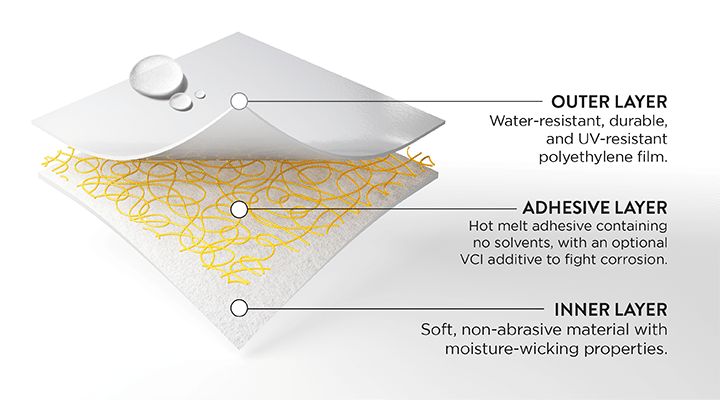How Does Transhield Perform in Cold Climates?
Protective Covers
When choosing a protective cover solution, performance in extreme weather conditions is a critical factor to consider. Although colder climates typically see slower corrosion rates due to lower relative humidity, potential risks such as salt spray from nearby oceans, road salt in icy conditions, and freeze thaw cycles can still pose a threat.
This piece will explore how Transhield’s three-layer shrink wrap material, known as The Shrinkable Fabric® , stands up against extreme cold climates.
Transhield’s Cold Weather Performance: Engineered for Flexibility
Transhield offers The Shrinkable Fabric in various film thickness configurations. These fabrics are not your average shrink wrap material; they’re made from a carefully engineered formula designed to withstand a broad spectrum of temperatures, from the freezing depths of winter to the scorching heat of summer. This adaptability is achieved through the selection and combination of materials throughout each layer of our material, each chosen for its performance characteristics:
- Outside Film Component: Depending on the application Transhield offers various thickness of its film. With its preparatory engineering, the outside film layers of The Shrinkable Fabrics utilize a special blend of plastic resins and masterbatch to create a polyethylene barrier that is flexible in severe cold, ensuring the covers remain durable and intact. A common problem in many single-layer PVC shrink wrap products is that they may become brittle overtime: leading to a loss of flexibility and increased vulnerability to failure from weather conditions or constant handling.
- Middle Adhesive Layer: The adhesive layer in Transhield is formulated to perform robustly in temperatures as low as -40°C (-40°F), maintaining its integrity without becoming brittle. Some of our fabrics have been tested down to -60°C (-76°F) in environmental chambers.
- Nonwoven Layer: While the inner fabric layer is less susceptible to temperature extremes, it’s engineered to withstand the shrinking operation’s open flame. This prevents the fibers from melting and becoming brittle, which could otherwise damage the surface it’s meant to protect.

R&D and Testing: Proof of Performance
To ensure top-notch performance in the cold, Transhield performs several rigorous R&D tests on our 5-10 mil material, along with all our other materials:
- 180-Degree Bend Test: Fabrics are stabilized at -40°C (-40°F) in a temperature and humidity chamber, then removed and bent to test for cracks and deformations, ensuring durability under extreme climatic stress. These tests are performed on fabric alone as well as heat sealed seams.
- Real-World Outdoor Testing: Transhield conducts extensive testing by covering bare metals and other test-objects, exposing them to outdoor conditions for up to a year at various locations, including cold climates at our Elkhart, IN headquarters and extreme heat conditions at our facilities in Texas.
- Transhield covers have been protecting products in real-world applications for 30 years, demonstrating durability and reliability in various climates, from the cold in Missouri to the tropical conditions in Hawaii. To read up on some of the field tests we’ve conducted over the years, check out our whitepaper section.
Specialized Features for Cold Weather Protection
The design of Transhield covers can include considerations for the extreme conditions:
- VCI Integration: For enhanced corrosion protection, certain fabrics are integrated with Vapor Corrosion Inhibitors (VCIs) in the middle adhesive layer; tested and proven to reduce corrosion by up to 95%.
- Durable Accessories: Added cover components such as TransTape®, buckles, and webbing are selected for their ability to withstand extreme conditions, ensuring overall durability and function of the cover system.
Conclusion: Consistent Protection in Extreme Conditions
By utilizing advanced material science, durable design features, and conducting rigorous R&D and field testing, Transhield delivers protective covers that you can trust to uphold the integrity of your equipment assets in extreme cold conditions.
Ready to Protect Your Assets No Matter the Weather?
Discover the unmatched durability and flexibility of Transhield’s protective fabrics. Whether it’s the freezing cold or the blistering heat, our tailored protective cover solutions are designed to keep your products in factory fresh condition. Don’t let extreme conditions threaten your valuable assets. Contact us today for a custom consultation and learn how Transhield can enhance your protective measures.


